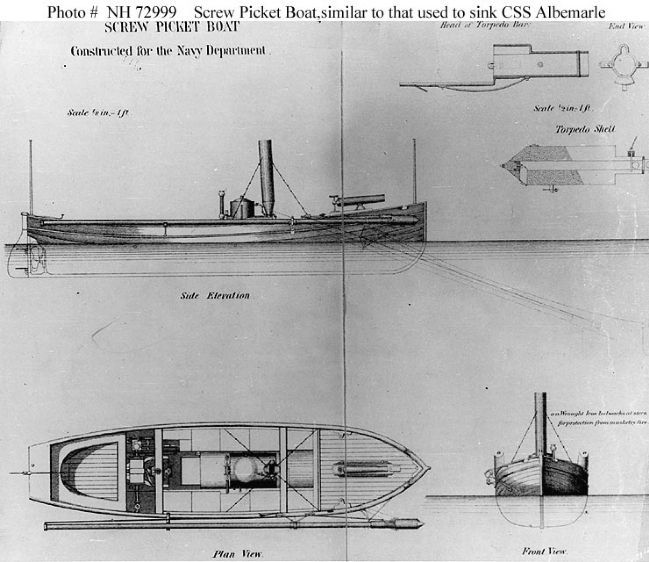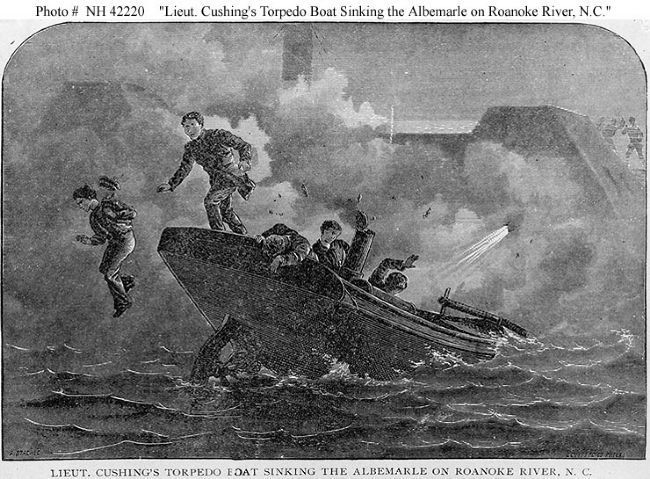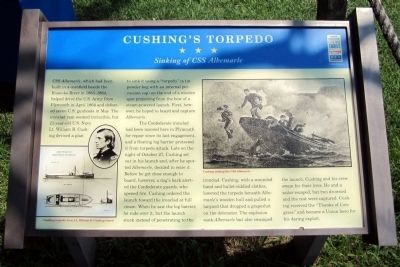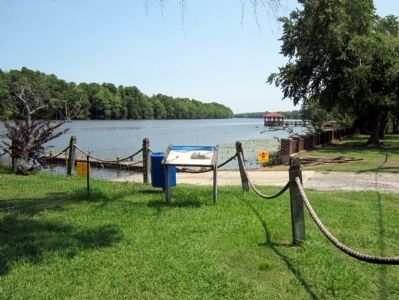Plymouth in Washington County, North Carolina — The American South (South Atlantic)
Cushing’s Torpedo
Sinking of CSS Albemarle
The Confederate ironclad had been moored here in Plymouth for repair since its last engagement, and a floating log barrier protected it from torpedo attack. Late on the night of October 27, Cushing set out in his launch and, after he spotted Albemarle, decided to seize it. Before he got close enough to board, however, a dog’s bark alerted the Confederate guards, who opened fire. Cushing ordered the launch toward the ironclad at full steam. When he saw the log barrier, he rode over it, but the launch stuck instead of penetrating to the ironclad. Cushing, with a wounded hand and bullet-riddled clothes, lowered the torpedo beneath Albemarle’s wooden hull and pulled a lanyard that dropped a grapeshot on the detonator. The explosion sank Albemarle but also swamped the launch. Cushing and his crew swam for their lives. He and a sailor escaped, but two drowned and the rest were captured. Cushing received the “Thanks of Congress” and became a Union hero for his daring exploit.
(captions)
Cushing torpedo boat, Lt. William B. Cushing (inset)
Cushing sinking the CSS Albemarle
Erected by North Carolina Civil War Trails.
Topics and series. This historical marker is listed in these topic lists: War, US Civil • Waterways & Vessels. In addition, it is included in the North Carolina Civil War Trails series list. A significant historical date for this entry is October 27, 1864.
Location. 35° 52.097′ N, 76° 44.981′ W. Marker is in Plymouth, North Carolina, in Washington County. Marker can be reached from the intersection of East Water Street and Adams Street, on the left when traveling east. Located on the waterfront behind the Plymouth Police Department and RBC Bank. Touch for map. Marker is at or near this postal address: 201 E Water St, Plymouth NC 27962, United States of America. Touch for directions.
Other nearby markers. At least 8 other markers are within walking distance of this marker. Siege of Plymouth, NC (about 500 feet away, measured in a direct line); CSS Albemarle (about 500 feet away); a different marker also named CSS Albemarle (about 500 feet away); Rt. Rev. Alfred Augustin Watson (about 500 feet away); Washington County Courthouse (about 500 feet away); Brick House Landing (about 500 feet away); Replica 6.4 inch Brooke Rifled Cannon (about 500 feet away); Battle of Plymouth (about 600 feet away). Touch for a list and map of all markers in Plymouth.

3. Screw Picket Boat similar to that used to sink the CSS Albemarle
General arrangement plan published in "Submarine Warfare, Offensive and Defensive", by Lieutenant Commander J.S. Barnes, USN, 1869. The drawing also includes detail drawings of the spar torpedo carried by this boat. This craft is similar to Picket Boat No. 1, which was used by Lieutenant William B. Cushing to sink the Confederate ironclad Albemarle on the night of 27-28 October 1864. Naval History and Heritage Command

4. Lieut. Cushing's Torpedo Boat sinking the Albemarle on Roanoke River, N.C.
Engraving by A. Stachic, published in "Naval Battles of America", by E. Shippen. It depicts the successful spar torpedo attack by Lieutenant William B. Cushing and his crew on the Confederate ironclad Albemarle, at Plymouth, North Carolina, 27 October 1864. Naval History and Heritage Command
Credits. This page was last revised on September 1, 2021. It was originally submitted on July 1, 2012, by Bernard Fisher of Richmond, Virginia. This page has been viewed 1,048 times since then and 31 times this year. Photos: 1, 2. submitted on July 1, 2012, by Bernard Fisher of Richmond, Virginia. 3. submitted on July 2, 2012, by Bernard Fisher of Richmond, Virginia. 4. submitted on July 1, 2012, by Bernard Fisher of Richmond, Virginia.

